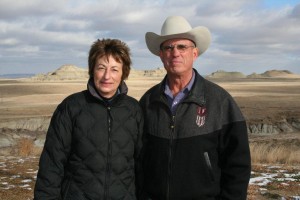Ranchers care.

Yet, in general ranchers care about what they produce.
“There isn’t a good cowperson out there who isn’t damn proud of his cattle,” feeder Tom Williams told me earlier this summer.
And with all the ranchers I’ve ever visited, I can say that definitely rings true.

Take Donn and Billie Hett from Buffalo, S.D. When I called them to talk about great carcass results, they shared that they like to build relationships with feedlots. They like repeat buyers and they like knowing they’re producing something the consumer wants.
So even though they might not directly see a check with Certified Angus Beef (R) premiums listed (like you’d get from a packer) they know that’s built in.
That matters as they’re picking genetics. Since 1978 it’s been all Angus and heavily focused on artificial insemination (AI).
“That way, we could use the better bulls at the price we could afford. Doing that, we could upgrade our herd a lot quicker,” Donn says. “Of any decision that we’ve made on this place, the AI has been one of the most important and rewarding. We use a proper balance, not head-over-heels one way or another. We look for well-muscled, easy keeping cattle that will gain well. The cattle have to work for us and for the feedlot.”

Pat Laird runs cattle just up the road from me near Cozad, Neb., and typically his calves go less than 5 miles to nearby Will Feed (a CAB-licensed feedyard that you may remember me mentioning before.)
He doesn’t retain ownership, but he’s more than happy to make investments in a good health program.
“[Manager Anne Burkholder] is back every year to buy them. I know when she comes back that tells me I must be doing something right,” Pat says.
Over the years they’ve coordinated those health programs. He gives a seven-way blackleg and bovine respiratory vaccine and makes sure Anne knows that.
“She’ll say, ‘Well, I’ll get this shot if you’ll get that shot.’” That eliminates duplication, but also makes sure the calves are fully protected and ready for life in the feedyard.
Keeping calves healthy is just simply the right thing to do—all ranchers want that. But to Laird, and so many others, it also has to do with all that research that shows healthy cattle are quality cattle.
“You have to have an end product that people want. That’s why we’re all in the business,” he says.
Tomorrow we’ll continue this trip by stopping in at the stocker phase.
May your bottom line be filled with black ink,
Miranda
Beef’s a Trip Archives:
Day 1: Starting at day one
Day 2: Who are these people?
Day 3: Stockholders
Day 4: The cowherd’s purpose
Day 5: Deciding to care
Day 6: Quality focus doesn’t have to skip the middleman
Day 7: Stocking for quality
Day 8: SOLD!
Day 9: What have you done today?
Day 10: Working together to make ‘em better
Day 11: Keep on truckin’
Day 12: Packers want quality
Day 13: The target
Day 14: Packers up close & personal
Day 15: It’s not all about the beef
Day 16: Further processors
Day 17: From here to there–and a lot more
Day 18: He’s on your team
Day 19: Beyond prices, grocery stores uncovered
Day 20: Getting quality in the carts
We’ve got a whole crew of ag bloggers writing their way through November. To check out the full list, visit Holly Spangler’s My Generation blog. She started all this!
